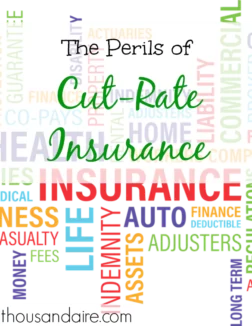A lot of people don’t like paying for car insurance; they see it as a monthly drain on their finances with no real return on their investment – especially since some policies can easily cost thousands of dollars a year. There are some insurance companies that offer substantial discounts on car insurance by offering what are called minimum coverage policies.
As the name suggests, minimum coverage polices offer the absolute minimum coverage that your state will allow you to have and still be legal. These minimums vary by state, with some states having substantially higher minimums than others.
The appeal of these minimum coverage policies is people can sometimes end up paying as little as half the cost of a similar policy from a different provider. The problem with these types of policies is that even at a discount they can cost you.
The Downside to Minimum Coverage Polices
The biggest problem with minimum coverage is that minimum coverage is often not enough. The average accident with injuries costs $126,000 – which includes injuries and property damage. If you have minimum coverage and your state only requires a minimum $3,000 for injuries, $2,500 for property, and a $60,000 per accident, there is no way that your minimum-coverage policy is going to cover the cost of the accident.
Another issue is that these policies tend to have very high deductibles, which could be impossible to meet. In some cases an insurance company will pay out their end of the claim and leave it to you to come up with the deductible. However, if you can’t come up with the money, then you won’t be able to get the repair. If you are in an accident with injuries, it could mean that the insurance company won’t pay out on the injury claim until you meet the deductible first.
Some of these policies also do not have adequate coverage for high-risk drivers. High risk drivers often have special needs, like needing an SR-22 document to be able to drive, and these minimum-coverage companies might not be able to provide that documentation. If they do provide high-risk coverage, chances are the cost is no less than you could find from another vendor, but with less coverage if you actually have an accident. It’s probably better to buy high risk insurance from a specialty vendor than from a discount company.
Keep in mind as well that if the insurance company is offering you such a great discount on coverage, it could be because it is cutting corners in other places, such as their systems, customer service or claims management. This means that you could encounter minor annoyances such as hinky phone systems; or major upsets, such as an incredibly cryptic and confusing claims process.
The other issue is that the company might also do everything it can to avoid paying the claim. It’s not unusual for any insurance company to avoid paying claims, but discount companies could be more likely to do so.
Alternatives to Minimum Coverage Policies
Find out what kind of discounts available from a standard insurance company. While many of these places are not as cheap as the cut-rate providers, you can often find discounts for having a clean driving record, or for bundling services like renters and homeowner’s policies with your car insurance. You might find that you can still save money by going with a standard insurance company, without having to compromise quality.
If you absolutely must go with a minimum coverage provider, make sure to do your homework:
· Look for consumer reviews as well as ratings to see if the company has a lot of complaints. You should also check with insurance rating companies like A.M Best, and independent consumer sites like Consumer Reports.
· Find out what other services the company may offer beyond just the minimum coverage. For example, some cut-rate insurers do not offer amenities like roadside assistance or car rental, both of which can come in handy if you have an accident.
· Set aside some of the money you have saved on the low premiums to pay the higher deductible if you need to file a claim.
Kevin McKee is an entrepreneur, IT guru, and personal finance leader. In addition to his writing, Kevin is the head of IT at Buildingstars, Co-Founder of Padmission, and organizer of Laravel STL. He is also the creator of www.contributetoopensource.com. When he’s not working, Kevin enjoys podcasting about movies and spending time with his wife and four children.

